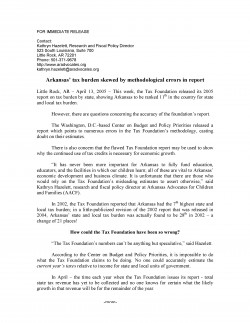
This week, the Tax Foundation released its 2005 report on tax burden by state, showing Arkansas to be ranked 11th in the country for state and local tax burden. However, there are questions concerning the accuracy of the foundation’s report. The Washington, D.C.-based Center on Budget and Policy Priorities released a report which points to numerous errors in the Tax Foundation’s methodology, casting doubt on their estimates. There is also concern that the flawed Tax Foundation report may be used to show why the continued use of tax credits is necessary for economic growth.
“It has never been more important for Arkansas to fully fund education, educators, and the facilities in which our children learn; all of these are vital to Arkansas’ economic development and business climate. It is unfortunate that there are those who would rely on the Tax Foundation’s misleading estimates to assert otherwise,” said Kathryn Hazelett, research and fiscal policy director at Arkansas Advocates for Children and Families (AACF).
In 2002, the Tax Foundation reported that Arkansas had the 7th highest state and local tax burden; in a little-publicized revision of the 2002 report that was released in 2004, Arkansas’ state and local tax burden was actually found to be 28th in 2002 – a change of 21 places!
How could the Tax Foundation have been so wrong?
“The Tax Foundation’s numbers can’t be anything but speculative,” said Hazelett. According to the Center on Budget and Policy Priorities, it is impossible to do what the Tax Foundation claims to be doing. No one could accurately estimate the current year’s taxes relative to income for state and local units of government.
In April – the time each year when the Tax Foundation issues its report – total state tax revenue has yet to be collected and no one knows for certain what the likely growth in that revenue will be for the remainder of the year.
Nationally, there are thousands of taxing units. The keeper of the collections data from these units is the US Census Bureau’s Government Finances Division. The Census Bureau works for years to collect and analyze the data for any given year and is recognized as the most reliable source of this data. If it takes a team at the Census Bureau several years to analyze the state and local tax data, how is the Tax Foundation able to know the state and local tax burden in the current year?
Hazelett says the Tax Foundation uses a model to estimate the state tax burden and these estimates should therefore be acknowledged as estimates rather than put forth as fact.
Other methodological errors in the Tax Foundation report include:
The misleading use of averages in the calculation of the tax burdens. This methodology overstates the tax burdens of the vast majority of families. The Congressional Budget Office analysis shows that most families pay considerably less in taxes than the Tax Foundation reports.
Taking into consideration tourism, severance, and business taxes, but leaving out property taxes when adjusting for taxes paid by people who live out-of-state. In a recent edition of Paychecks and Politics, it was noted that 14% of timberland in 26 Arkansas counties was owned by some one from out-of-state. Ignoring these out-of-state property owner/taxpayers and others like them skews the adjustment.
Artificially inflating the tax burden by counting taxes paid on capital gains while
ignoring the capital gains income on which the taxes were paid. Even Alan
Greenspan has declared this method to be invalid. Counting as taxes certain non-tax items including premiums that older Americans can elect to pay for Medicare Part B further inflating the tax burden.
